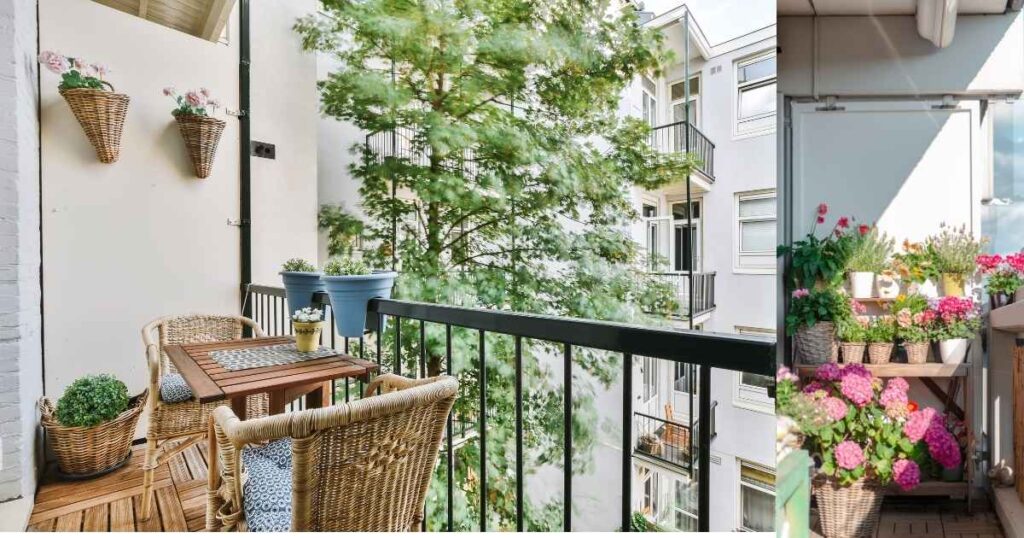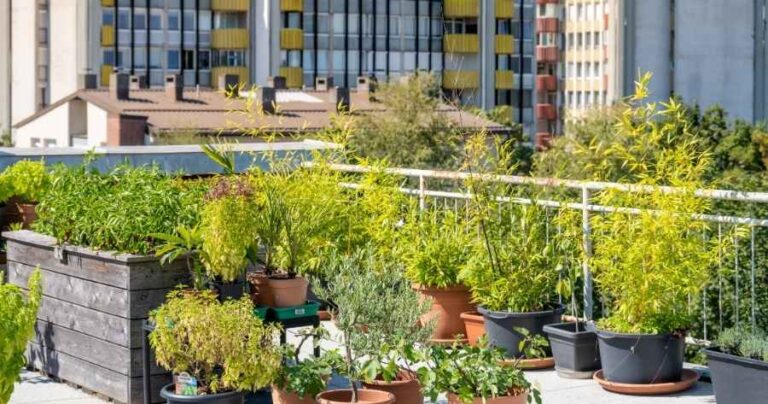
Living in a city doesn’t mean you have to give up on greenery. A balcony garden is the perfect way to bring nature into your home, even if you live in a small apartment. With a bit of planning and creativity, you can turn your balcony into a lush, productive space full of life. This guide walks you through everything you need to know to start your own balcony garden, no matter how small your space is.

Understand Your Balcony Space
Before buying pots or plants, take time to assess your balcony:
Measure the Space
Start by measuring your balcony’s length and width. Knowing the exact size will help you determine how many pots you can fit, and what kind of layout to plan.
Observe the Sunlight
Sunlight is crucial. Watch how much sunlight your balcony receives throughout the day.
- Full Sun (6–8 hours): Ideal for most vegetables and herbs.
- Partial Sun (3–5 hours): Suitable for leafy greens and shade-tolerant plants.
- Shaded (less than 3 hours): Go for ferns, ivy, and low-light herbs like mint.
Balconies facing south or west get the most sun, while north-facing ones receive less.
Choose the Right Containers
In small spaces, smart container choices make a big difference.
Types of Containers You Can Use:
- Hanging Baskets: Save floor space by hanging plants from railings or overhead bars.
- Vertical Planters: Ideal for herbs, small flowers, and even strawberries.
- Rail Planters: Attach to balcony railings to utilize edge space.
- Grow Bags: Inexpensive, space-saving, and perfect for vegetables like potatoes and tomatoes.
- Window Boxes: Great for herbs and colorful flowers.
Make sure all containers have drainage holes to prevent overwatering.
Select the Right Plants for Small Spaces
Choosing the right plants depends on the climate, sunlight, and how much care you’re willing to provide.
Best Plants for Balcony Gardens:
Herbs (Low-maintenance and useful)
- Basil – Loves sun; great for salads and cooking.
- Mint – Grows fast; keep it in a separate pot to prevent spreading.
- Parsley – Grows well in partial sunlight.
- Thyme & Oregano – Compact and flavorful.
Vegetables (Compact and productive)
- Cherry Tomatoes – Best in sunny balconies; need staking or cages.
- Lettuce – Grows quickly and thrives in cooler temperatures.
- Spinach – Tolerates shade; grows well in shallow containers.
- Chili Peppers – Great for sunny balconies and easy to maintain.
Ornamental Plants
- Petunias, Marigolds, and Geraniums – Add color and attract pollinators.
- Ferns and Pothos – Ideal for shady balconies and improve air quality.
- Succulents and Cacti – Low maintenance and space-efficient.
Note: Choose dwarf or bush varieties where possible to save space.
Make Use of Vertical Space
When floor space is limited, go vertical.
Ideas to Maximize Space:
- Wall Planters: Attach fabric or wooden planters to walls.
- Ladder Stands: Stack pots on wooden ladders for tiered display.
- Hanging Hooks and Shelves: Suspend small pots or place them on sturdy racks.
- Trellises: Grow climbing plants like beans, cucumbers, or morning glories upward instead of outward.
Going vertical increases your growing area and gives your garden a layered, organized look.
Use the Right Soil and Fertilizer
Balcony gardens thrive best in high-quality soil.
Choose:
- Potting Mix: Light, well-draining, and contains essential nutrients.
- Organic Compost: Boosts plant health and improves soil structure.
- Liquid Fertilizers: Feed your plants every 2–3 weeks with diluted organic fertilizers (like fish emulsion or seaweed extract).
Avoid using regular garden soil, it’s too heavy for containers and may contain pests or weeds.
Watering Tips for Balcony Plants
Watering is critical in container gardening, especially in warm or windy conditions.
Smart Watering Practices:
- Check Soil Moisture: Stick your finger 1–2 inches deep; water only if it feels dry.
- Morning or Evening: Water early or late in the day to reduce evaporation.
- Self-Watering Pots: Help maintain consistent moisture.
- Mulching: Use coconut husk, straw, or leaves to retain moisture and reduce watering needs.
Avoid overwatering. Drainage is just as important as hydration.
Deal with Weather and Pests
Balconies are exposed to wind, rain, and extreme temperatures.
Protection Tips:
- Wind Screens: Use bamboo blinds or mesh to reduce wind damage.
- Shade Cloths: Protect from excessive sunlight during hot seasons.
- Moveable Pots: Use lightweight containers that you can relocate during storms.
- Natural Pest Control: Use neem oil spray, garlic water, or plant marigolds to deter pests naturally.
Be prepared to monitor your plants daily, especially in extreme weather.
Decorate and Personalize Your Balcony Garden
Make your space functional and inviting.
Design Ideas:
- Add a small foldable chair or stool for relaxing.
- Use colorful pots to brighten up the space.
- Hang string lights or lanterns for cozy evening vibes.
- Paint DIY signs or plant labels for charm and organization.
A balcony garden isn’t just for growing plants—it can be your peaceful escape.
Conclusion
Starting a balcony garden in a small space is both fun and rewarding. You don’t need acres of land to grow fresh herbs, veggies, or flowers. With a few pots, some sunlight, and a little care, you can create a lush oasis right outside your window.
Whether you’re growing for beauty, relaxation, or food, a balcony garden brings life, freshness, and a touch of nature into even the most urban spaces.




